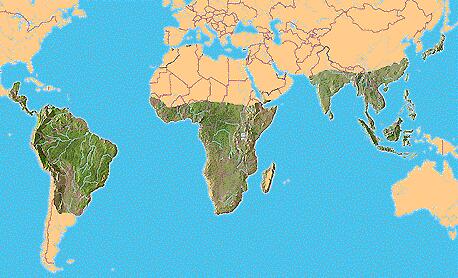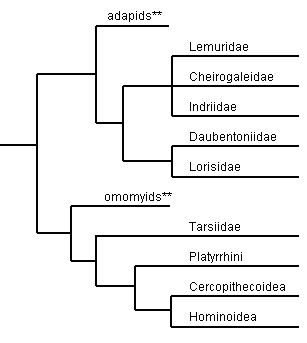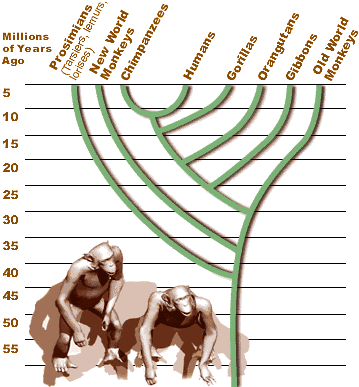 |
![]()
|
If you are in a hurry to get information about some species of primate, click on one of the four links below to go to that section of the primate world. If you are not sure about the precise name or location of a species, use the species index to help you find what you are looking for. If you have time to read about the history of primates, the number of species and about wildlife illustrations, scroll down the page for more information. Thanks for visiting -- come back soon. |
[ Menu | Prosimians | New World Monkeys | Old World Monkeys | Gibbons & Great Apes ]
[ Primate Species Index ]
[ Return to ZOOLOGY
| Return to EVOLUTION ]
"I Didn't Come From Any Monkey!"
|
|

|

Primate Family Tree from the Philadelphia Enquirer's Going Ape! website. |
| Anatomy -- Bones, Flesh and Genes |
|
Scientists use a variety of information upon which to base cladistic trees. The distribution and age of fossils (Paleontology), and comparison of bones, muscles and internal organs (Morphology) are now joined by the study of genes (Molecular Biology) to judge the relatedness of living and fossil species. Generally speaking, however, we cannot yet use genetics for the study of very ancient fossils.
|
Data from The Third Chimpanzee by Jared Diamond, 1992.
What is a species? It is a population of organisms (primates in this case) that does not breed with other populations of animals. All human beings are one species, Homo sapiens. What about very similar populations (or even those different in appearance) that neighbor each other but have no contact? They could be a single species having separate populations, a species having two somewhat distinctive subspecies, or they might be two species. Sometimes it is difficult to know for sure what is the case. Because there is some difficulty in knowing species lists can vary greatly. Advanced students may wish to read What is a Species, and What is Not? by Dr. Ernst Mayr, considered by many to be the dean of American Biologists and Taxonomists.
First, notice that these two lists are identical. On the left the short form of notation is used to save space. The first name is the "nominate species." If there are any named subspecies they must be given a distinct subspecific name (the third name you see). A different specialist may think that the Northern Black Colobus is a distinct or full species and refer to it as Colobus caudatus. In some cases that subspecies might even appear as a distinct species in another genus. So, if you have difficulty finding a species here, be sure to use your browser's "find" feature (usually under "Edit" at the top of your screen) to see if the name appears in a similar nearby genus.

About Species and Subspecies
Many animals are not well studied in nature so our current lists of species depend much on the opinions of specialists who sometimes have to work with little information. One "authority" may see several species where another sees only one. You will see on the primate listings something like this:
Colobus guereza -- Abyssinian Colobus
C. g. caudatus -- Northern Black Colobus
C. g. kikuyuensis -- Colobus
Colobus guereza guereza -- Abyssinian Colobus
Colobus guereza caudatus -- Northern Black Colobus
Colobus guereza kikuyuensis -- Colobus
The last point about subspecies is that it is sometimes very difficult to see any differences between them, especially in photographs. To illustrate this point I have prepared another page on which is discussed the forms of wildlife artwork and the quality of material available on the Internet. See the pages on Primate Artwork and the photograpic comparisons of Chlorocebus Species.
[ Primate Species Index ] [ Return to ZOOLOGY | Return to EVOLUTION ]
